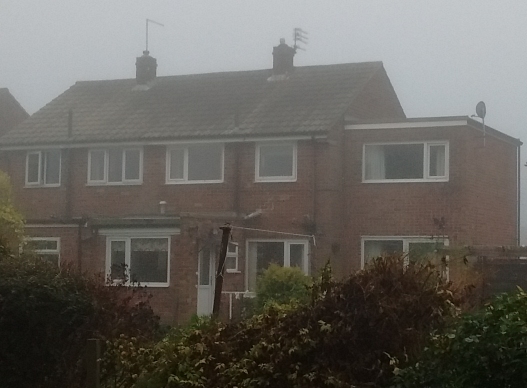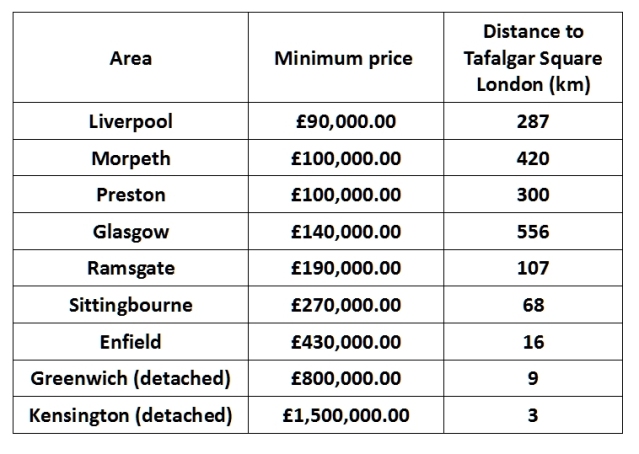Written for a housing policy forum. Part 5
Construction is a fraction of the cost
The cost of building a traditional house is a modest part of the cost of a new home: In York it is less than the cost of the land when it has planning permission. Not long ago it has been possible to build an individual 3 bed roomed house for about £50,000. I know someone had one built for £50,000 – on land they already owned.

Bricks and mortar houses built in the conventional style
Regional prices for new houses
Looking on Zoopla.co.uk for the price of new build 3 bed semi-detached houses gave these prices, (rounded up to the neatest £10,000).
Note for NERDs:
For the English towns, the statistical measure R-squared between
minimum prices and the square root of the distance from London
is 0.6. Statistical texts can describe this as 60% explanation.
The cost of building and development does vary a bit throughout the country. The website Total Jobs shows salaries for construction that are 50% higher in Central London than the rest of the country but in North London and West London, a few miles away, they are only slightly above the norm.
House prises in Enfield, North London, at more than four times the price of houses in the North of England. This is not caused by building costs. It is not caused by the cost of materials. It is the development value of the land that makes the difference. Across the most of UK the cost of construction for simiar buildings does not differ very much.
The development value of land for building is almost completely the value of the planning permission. Without the possibility of planning permission, nearly all the value disappears from “development land” disappears. The value of the planning permission is high in places where the demand for housing exceeds the supply. In areas surrounded by open countyside, like York, the lack of planing permission was examined in part 4 and will be discussed further in Housing – part 7: Green belt policy.
Modern prefabs: Cheap and with low carbon emissions
New models of building are becoming available. The exciting Wikihouse development, where new technology and open source designs mean the potential house owner has much more control. See the Ted Talk, Architecture for the people by the people, where
designer Alastair Parvin presents a simple but provocative idea: what if, instead of architects creating buildings for those who can afford to commission them, regular citizens could design and build their own houses? The concept is at the heart of WikiHouse, an open source construction kit that means just about anyone can build a house, anywhere.
Other new construction methods include factory made houses such as those planned by Legal and General: Houses made in factories from Cross Laminated Timber (CLT), which sounds like a more substantial version of something we usually call plywood. Sadly L&G seem to have removed their video of the construction process from their website. Rumours that I have heard suggest that the manufacturing cost for L&G houses is £30, 000 per unit.
In Part 1, I discussed the greenhouse gasses emitted in building a conventional carbon in a conventional bricks and mortar house. These are so large as to be comparable with our personal remaining carbon budgets. Wooden houses can be made so that their construction sequesters more carbon than is emitted. i.e. Their construction is carbon negative.
In the static caravans market prices can be very much less, with prices for log cabins starting at less than £10,000. What is a “static caravan”. Cynically – and probably truthfully – it is a structure that can be lived in but to dodge restrictive planning rules is classed as temporary and moveable.
Some of these are structures reminiscent of the postwar prefabs and the government is considering prefab development as the Telegraph reported in Britain set for new wave of prefabs to help tackle housing crisis (Oct 2016)
“While the Communities Department is not expected to set a hard target, government sources said it was hoped that the change would result in more than 100,000 prefabs being built over this parliament.
Gavin Barwell, the housing minister, today confirms that the Government sees a “huge opportunity” in manufacturers building houses off-site as it tries to hit ambitious building targets.
Winston Churchill backed a surge in prefabs that helped families across Britain left homeless after the Blitz.
The homes – designed to last only 10 years but often still habitable for decades longer – came to symbolise Britain’s post-war years but were often also synonymous with poor quality.”
The decription “synonymous with poor quality” is unfair. Post war prefabs were meant to last 5 or 10 years but some have lasted 60 years and prefabs have been removed for planning reasons many of these spurious. They were much more successful with their residents than planners and politicians have been willing to admit. Here is a section from Prefabs are for People.
Briefly:
People liked prefabs
Multistorey mass housing failed
The planners didn’t notice
They will get it wrong again
Planners ignore happy residents
Prefabs, the “temporary” homes built after the World Wars of the twentieth century, were one of the great housing successes in the past 100 years. They were meant to last 5 or 10 years but some have lasted 60 years. But the big story is that the residents liked them. See, for example, Wolverhampton History and Heritage Society article on Tarran Bungalows on the East Park Estate.)
“It is a great tribute to the original design and building of these houses that, although intended to last for only 10 years, nearly 60 years later their residents are still happy in them.”
BrusselsBlog has a piece Prejudicess and housing: Prefabs. Later sections will examine this prejudice – and the social success of many of the prefab sites , which gve a sense of community and belonging. This may be a lesson for the future but the message for now is that dwellings can be made much cheaper than “traditional” bricks and mortar construction – and can have much lower carbon footprints.
Postscript 13th March 2018: Cheap 3D printed houses
In and article in Wired Magazine, The Quest to Bring 3-D-Printed Homes to the Developing World, Arielle Pardes writes about new methods :
In the low-slung hills of El Salvador, building a house is not an easy task. The land is vulnerable to earthquakes, flooding, volcanic eruptions. The roads are rugged, electricity sparse. For the past several years, New Story—a housing charity based in San Francisco—has built over 150 homes there, replacing tarps and scrap metal shelters with houses that have proper roofs and floors. It’s slow, painstaking work in a country where nearly a third of the population is without shelter.
And…
Using current traditional methods, it takes New Story eight months to build a community of 100 homes, which cost about $6,000 each. With a 3-D printer, it says it can build one home a day at a cost of $4,000 per structure. If New Story succeeds, the first people to live in a 3-D-printed town won’t be the technologists or the futurists of Silicon Valley. They’ll be people in the world’s poorest regions, who most need a roof over their heads.
There are people in the UK who ‘need a roof over their heads’. $4,000 is £2,866 at today’s exchange rate. So add some extra insulation, a modern cesspit, some nice tree planting, off-grid electricity some bike tracks and we have a starter home – or a place for old people like me – for a small fraction of the cost of a traditional house in Britain.
(18th March 2018: See also BBC article on this method)
Unless, of course, it’s necessary to pay £100,000 or so to cover the cost of the planning permission.
Postscript 10th June 2019: A target construction cost for starter homes could be £30,000
In Starter homes for less than £20k I say
At agricultural prices a plot big enough for a house with a reasonably sized garden costs about £1000. A starter home, the M2, shown in this second video, can be bought from Poland for about £10,000. There are other options this cheap.
Add a £(a few thousand) for connections and external works and a starter home for under £20,000 looks possible.
For further discussion, perhaps this could be raised to £30,000., in line with the rumours about the costs of prefabrication of a new Legal and General home, which are more than just starter homes.